Related Research Articles
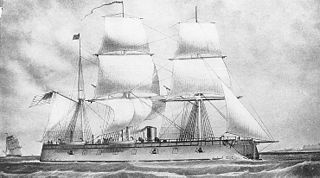
USS New Ironsides was a wooden-hulled broadside ironclad built for the United States Navy during the American Civil War. The ship spent most of her career blockading the Confederate ports of Charleston, South Carolina, and Wilmington, North Carolina, in 1863–65. New Ironsides bombarded the fortifications defending Charleston in 1863 during the First and Second Battles of Charleston Harbor. At the end of 1864 and the beginning of 1865 she bombarded the defenses of Wilmington in the First and Second Battles of Fort Fisher.

The Defence-class ironclads were a class of two warships built for the Royal Navy between 1859 and 1862. The ships were designed as armoured frigates in response to an invasion scare sparked by the launch of the French ironclad Gloire and her three sisters in 1858. They were initially armed with a mix of rifled breech-loading and muzzle-loading smoothbore guns, but the Armstrong breech-loading guns proved unreliable and were withdrawn from service after a few years.

An Armstrong gun was a uniquely designed type of rifled breech-loading field and heavy gun designed by Sir William Armstrong and manufactured in England beginning in 1855 by the Elswick Ordnance Company and the Royal Arsenal at Woolwich. Such guns involved a built-up gun construction system of a wrought-iron tube surrounded by a number of wrought-iron strengthening coils shrunk over the inner tube to keep it under compression.

The Brazilian ironclad Tamandaré was an armored gunboat built for the Imperial Brazilian Navy during the Paraguayan War in the mid-1860s. She bombarded the Paraguayan fortifications blocking access up the Paraná and Paraguay Rivers as well as bombarding Paraguayan positions in support of the Imperial Brazilian Army. The ship participated in the Passage of Humaitá in February 1868 and was badly damaged. After Tamandaré was repaired she provided fire support for the army for the rest of the war, aside from bombarding Paraguyan capital of Asunción once. The ship was assigned to the Mato Grosso Flotilla after the war. Tamandaré was decommissioned in 1879 and scrapped afterwards.

The Brazilian ironclad Brasil was an armored corvette built in France for the Brazilian Navy in the mid-1860s. Configured as a central-battery ironclad, she served during the 1864–70 War of the Triple Alliance between Brazil, Argentina and Uruguay against Paraguay.

The Pará-class monitors were a group of six wooden-hulled ironclad monitors named after Brazilian provinces and built in Brazil for the Imperial Brazilian Navy during the Paraguayan War in the late 1860s. The first three ships finished, Pará, Alagoas and Rio Grande, participated in the Passage of Humaitá in February 1868. Afterwards the remaining ships joined the first three and they all provided fire support for the army for the rest of the war. The ships were split between the newly formed Upper Uruguay and Mato Grosso Flotillas after the war. Alagoas was transferred to Rio de Janeiro in the 1890s and participated in the Fleet Revolt of 1893–94.
The Brazilian monitor Pará was the lead ship of the Pará-class river monitors built for the Brazilian Navy during the Paraguayan War in the late 1860s. Pará participated in the Passagem de Humaitá in February 1868 and provided fire support for the army for the rest of the war. The ship was assigned to the Mato Grosso Flotilla after the war. Pará was disarmed and discarded in 1884.

The Brazilian monitor Rio Grande was the second ship of the Pará-class river monitors built for the Brazilian Navy during the Paraguayan War in the late 1860s. Rio Grande participated in the Passagem de Humaitá in February 1868 and provided fire support for the army for the rest of the war. The ship was assigned to the Upper Uruguay Flotilla after the war. Rio Grande was scrapped in 1907.
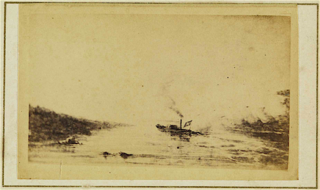
The Brazilian monitor Alagoas was the third ship of the Pará-class river monitors built for the Brazilian Navy during the Paraguayan War in the late 1860s. Alagoas participated in the Passage of Humaitá in February 1868 and provided fire support for the army for the rest of the war. The ship was assigned to the Upper Uruguay Flotilla after the war. Alagoas was transferred to Rio de Janeiro in the 1890s and participated in the Fleet Revolt of 1893–94. The ship was scrapped in 1900.
The Brazilian monitor Piauí was the fourth ship of the Pará-class river monitors built for the Brazilian Navy during the Paraguayan War in the late 1860s. Piauí passed the fortifications at Humaitá in July 1868 and provided fire support for the army for the rest of the war. The ship was assigned to the Mato Grosso Flotilla after the war. Piauí was scrapped in 1893.
The Brazilian monitor Ceará was the fifth ship of the Pará-class river monitors built for the Brazilian Navy during the Paraguayan War in the late 1860s. Ceará arrived in Paraguay in mid-1868 and provided fire support for the army for the rest of the war. The ship was assigned to the Mato Grosso Flotilla after the war. Ceará was scrapped in 1884.
The Brazilian monitor Santa Catharina was the sixth, and last, ship of the Pará-class river monitors built for the Brazilian Navy during the Paraguayan War in the late 1860s. By the time she was completed the war was winding down and she only had one significant engagement against Paraguayan forces in 1869. The ship was assigned to the Mato Grosso Flotilla after the war. Santa Catharina sank at her moorings while under repair in 1882.

The 70-pounder Whitworth naval gun was designed by Joseph Whitworth during the 1860s. It was a rifled muzzle loader and used his hexagonal, rifled-bore design.

The Brazilian monitor Bahia was originally ordered by Paraguay in 1864 with the name Minerva, but was sold to Brazil when Paraguay defaulted on the payments. She participated in the 1864–70 War of the Triple Alliance between Brazil, Argentina and Uruguay against Paraguay, and took part in the Passage of Humaitá.

The Brazilian ironclad Lima Barros was originally ordered by Paraguay in 1864 with the name Belona, but was sold to Brazil when Paraguay could not make the final payments. She participated in the 1864–70 Paraguayan War between Brazil, Argentina and Uruguay against Paraguay.
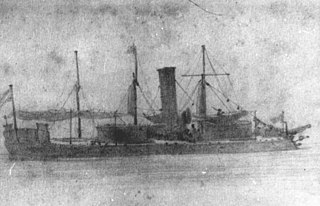
The Brazilian ironclad Silvado was originally ordered by Paraguay in 1864 with the name Nemesis, but was sold to Brazil when Paraguay could not make the final payments. She participated in the 1864–70 War of the Triple Alliance between Brazil, Argentina and Uruguay against Paraguay.
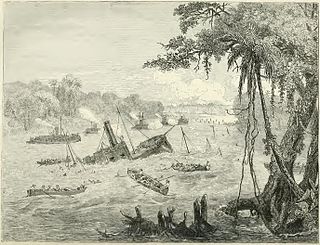
The Brazilian ironclad Rio de Janeiro was an armored gunboat built for the Brazilian Navy during the Paraguayan War in the mid-1860s. Like the other two gunboats she was built in Brazil and was designed as a casemate ironclad. Commissioned in April 1866, the ship did not enter combat until September, when she bombarded Paraguayan fortifications at Curuzu. Rio de Janeiro hit two mines on 2 September and rapidly sank, taking 53 of her crew with her.

The Brazilian ironclad Sete de Setembro was a wooden-hulled armored frigate built for the Brazilian Navy during the Paraguayan War in the late 1860s. Construction was delayed by a debate over her armament and she was not completed until 1874, by which time the ship was essentially obsolete. Sete de Setembro was transferred to Rio de Janeiro in the 1880s and captured by the rebels during the Fleet Revolt of 1893–94. She sank after she caught fire when the government forces recaptured her in late 1893.

The Brazilian ironclad Barroso was an armoured gunboat built for the Brazilian Navy during the Paraguayan War in the mid-1860s. Barroso bombarded Paraguayan fortifications in 1866 and 1867 a number of times before she participated in the Passagem de Humaitá in February 1868. Afterwards the ship provided fire support for the army for the rest of the war. She was assigned to the Mato Grosso Flotilla after the war. Barroso was decommissioned in 1882, but was not scrapped until 1937.
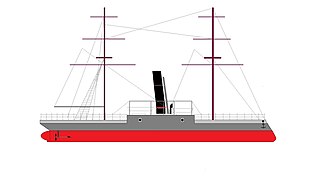
The Mariz e Barros-class ironclads were a pair of armored corvettes originally ordered by Paraguay in 1864, but were sold to Brazil when Paraguay defaulted on the payments. Configured as central-battery ironclads, they served during the 1864–70 Paraguayan War between Brazil, Argentina and Uruguay against Paraguay. They were named after Antônio Carlos de Mariz e Barros (1835–1866), son of Joaquim José Inácio, Viscount of Inhaúma, Brazilian military officer and hero of the Paraguayan War.
References
- Gratz, George A. (1999). "The Brazilian Imperial Navy Ironclads, 1865–1874". In Preston, Antony (ed.). Warship 1999-2000. London: Conway Maritime Press. ISBN 0-85177-724-4.
- Alexander Lyman Holley, "A Treatise on Ordnance and Armor" published by D. Van Nostrand, New York, 1865